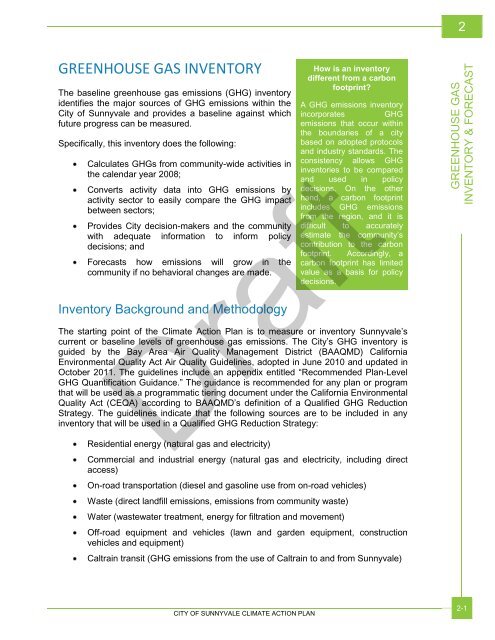DRAFT Climate Action Plan - PMC
DRAFT Climate Action Plan - PMC
DRAFT Climate Action Plan - PMC
You also want an ePaper? Increase the reach of your titles
YUMPU automatically turns print PDFs into web optimized ePapers that Google loves.
2<br />
GREENHOUSE GAS INVENTORY<br />
The baseline greenhouse gas emissions (GHG) inventory<br />
identifies the major sources of GHG emissions within the<br />
City of Sunnyvale and provides a baseline against which<br />
future progress can be measured.<br />
Specifically, this inventory does the following:<br />
Calculates GHGs from community-wide activities in<br />
the calendar year 2008;<br />
Converts activity data into GHG emissions by<br />
activity sector to easily compare the GHG impact<br />
between sectors;<br />
Provides City decision-makers and the community<br />
with adequate information to inform policy<br />
decisions; and<br />
Forecasts how emissions will grow in the<br />
community if no behavioral changes are made.<br />
Inventory Background and Methodology<br />
The starting point of the <strong>Climate</strong> <strong>Action</strong> <strong>Plan</strong> is to measure or inventory Sunnyvale’s<br />
current or baseline levels of greenhouse gas emissions. The City’s GHG inventory is<br />
guided by the Bay Area Air Quality Management District (BAAQMD) California<br />
Environmental Quality Act Air Quality Guidelines, adopted in June 2010 and updated in<br />
October 2011. The guidelines include an appendix entitled ―Recommended <strong>Plan</strong>-Level<br />
GHG Quantification Guidance.‖ The guidance is recommended for any plan or program<br />
that will be used as a programmatic tiering document under the California Environmental<br />
Quality Act (CEQA) according to BAAQMD’s definition of a Qualified GHG Reduction<br />
Strategy. The guidelines indicate that the following sources are to be included in any<br />
inventory that will be used in a Qualified GHG Reduction Strategy:<br />
Residential energy (natural gas and electricity)<br />
Commercial and industrial energy (natural gas and electricity, including direct<br />
access)<br />
On-road transportation (diesel and gasoline use from on-road vehicles)<br />
Waste (direct landfill emissions, emissions from community waste)<br />
Water (wastewater treatment, energy for filtration and movement)<br />
How is an inventory<br />
different from a carbon<br />
footprint?<br />
A GHG emissions inventory<br />
incorporates GHG<br />
emissions that occur within<br />
the boundaries of a city<br />
based on adopted protocols<br />
and industry standards. The<br />
consistency allows GHG<br />
inventories to be compared<br />
and used in policy<br />
decisions. On the other<br />
hand, a carbon footprint<br />
includes GHG emissions<br />
from the region, and it is<br />
difficult to accurately<br />
estimate the community’s<br />
contribution to the carbon<br />
footprint. Accordingly, a<br />
carbon footprint has limited<br />
value as a basis for policy<br />
decisions.<br />
Draft<br />
Off-road equipment and vehicles (lawn and garden equipment, construction<br />
vehicles and equipment)<br />
Caltrain transit (GHG emissions from the use of Caltrain to and from Sunnyvale)<br />
GREENHOUSE GAS<br />
INVENTORY & FORECAST<br />
CITY OF SUNNYVALE CLIMATE ACTION PLAN<br />
2-1


